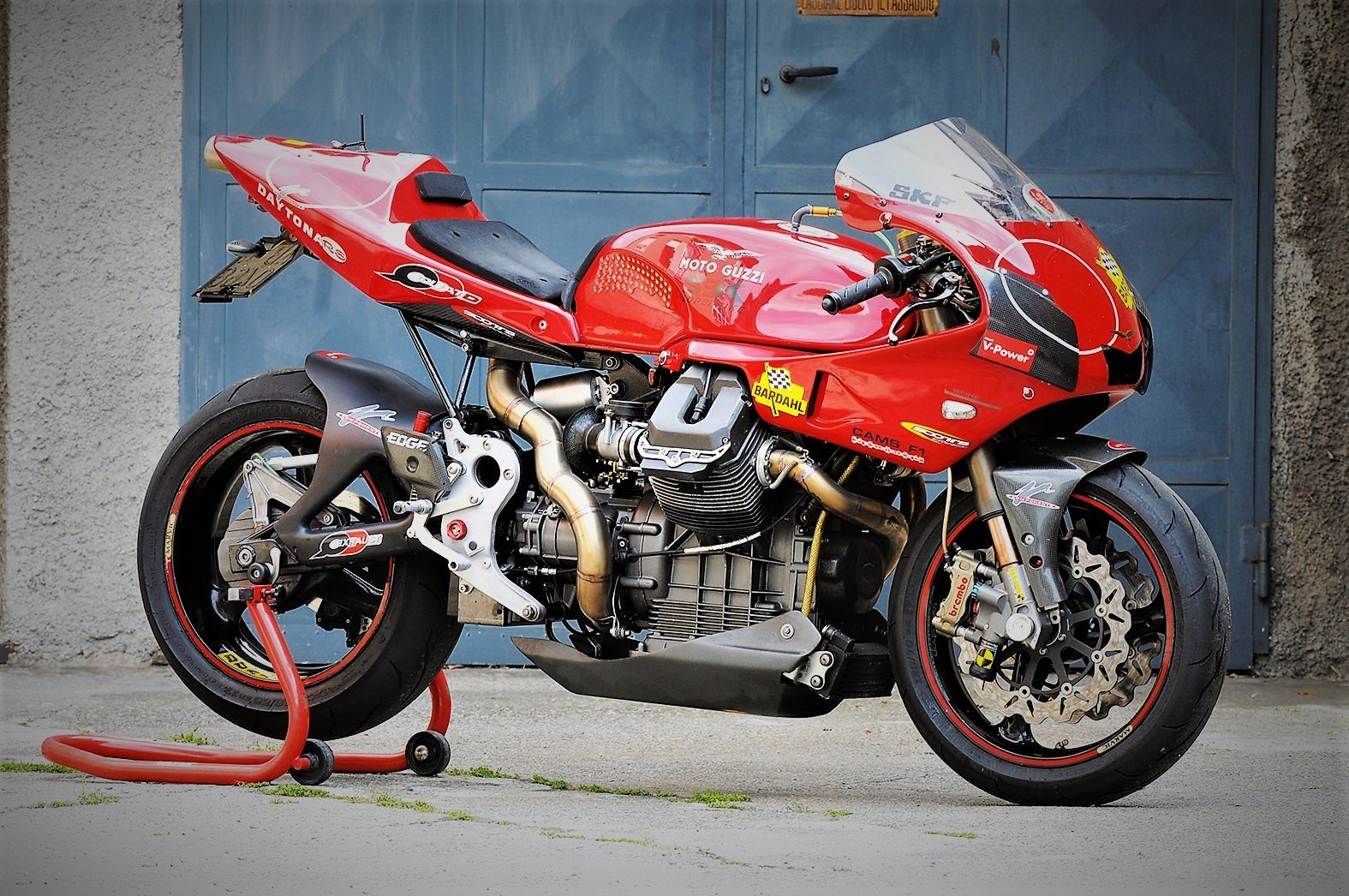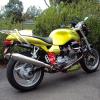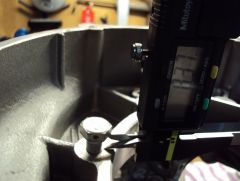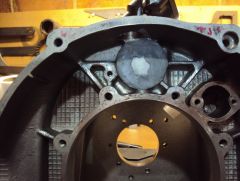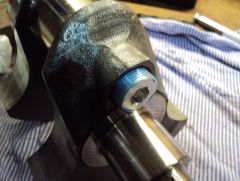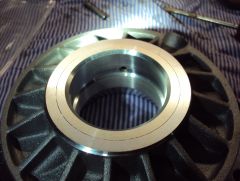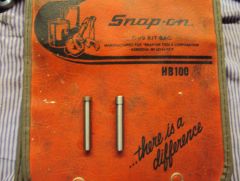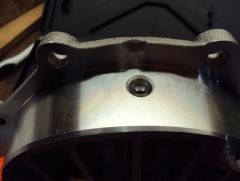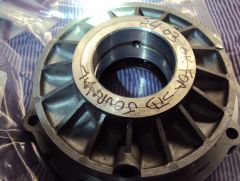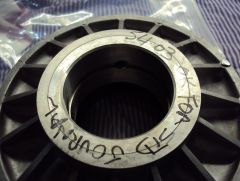-
Posts
5,223 -
Joined
-
Last visited
-
Days Won
268
Everything posted by Lucky Phil
-
Ha,excellent. Will do thanks. Ciao
-
Thought you already had that covered Pete, along with me Ciao
-
Well after doing the priority task (installing 2 600 liter water tanks for the wifes gardening) I managed to sneak an hour or so on the Daytona engine. I cleaned out the crank and oil galleries and fitted the new plug. Here's a tip...when you trial fit the plug and tighten it up re check the interior of the crank pin again for aluminium particles off the plug. The last thread or so of the plug can get shaved by the end threads in the crank and the shavings end up inside the pin bore. Happened in this case to me. Re cleaned the bore of the pin and loctited the plug in place. I'll give it a couple of punch marks tomorrow when the loctite has cured. I also roughed up the rear cam bearing blank and applied some hi temp JB weld as has been suggested by some. Belts and braces I guess. Hmm.....doesn't look quite this horrid in the flesh thank goodness. Ciao
-
Thanks for the image, the guard seems to compliment the style of the bike nicely. Ciao
-
Very neat docc. Ciao
-
Very nice work. Can you post a shot of the whole bike side on? Ciao
-
Well these days sand cast is more suited to small production runs as there is no investment in expensive tooling just the cheaper patterns. It also enables you implement modifications to the casting quickly and cheaply buy modding the pattern. Some claim the materials are stronger but the shapes need to be a little less complex to get the material to flow into the mold compared to pressure die cast. Its a good question. My Ducati 1198s uses pressure diecast crankcases but the R version (and therefore the WSB bikes at the time) used heavier and stronger sand cast cases. So they were Homologated with the sand cast cases. I remember the Ducati sand cast bevel cases from the 70's and most had Araldite in them somewhere to fill porosity and voids. But then again the pressure diecast ones on the 80's and 90's eight valvers also suffered from porosity. Chuck may be able to chime in with more detailed info. Ciao
-
No, this new bearing and carrier just have a slightly larger drilling for the restrictor and a deeper shoulder for it to sit on. Not sure why. Its also a sand cast carrier as well and the original is diecast. I think it came from HMB Guzzi in Germany and may be an aftermarket piece. Its nicely made and I have no issues using it it just differs in details. The original restrictor would have contacted the crank journal on the new one. The carrier is a separate part with a single piece double track bearing pressed into it by the looks of things. Same for both old and new. Ciao
-
-
-
Machined up a new rear main bearing carrier oil feed restrictor today. Same overall length just a longer shoulder and slightly larger OD to position it in the carrier and fit the drilling better. Ciao
-
From the album: lucky phils V11
-
From the album: lucky phils V11
-
Thanks Scud, I went the whole 9 yards on the paint prep wise. Stripped the cases soda blasted most then used mag wheel cleaner on the parts for 10 min and hosed it off and painted within 2 days. Then I cured it all in the oven. If it doesnt stick now it never will. I have stripped about 90% of the crinkle finish gearbox, what a nightmare that stuff is. In some places the paint is over 1mm thick. I'll strip it apart as you did and do the painting properly. Ciao
-
Yes Chuck, thinking about it I might just turn up a new restrictor as not only is it too long but its also a loose fit in the bearing carrier where its a neat fit in the original. There would be a significant amount of oil bypassing the restrictor in the new set up. Notice as well the new bearing carrier has a boss for the oil hole to the seal area at 1 o'clock but the original only has a hole with no boss.Need to think about that one, maybe better oil supply to the seal area? Dont know. Ciao
-
Thanks Jaap, good to know the 15M can be used with the old style TPS. Now I need to source a Daytona/Centauro map for the 15M and use Guzzidiag to load it I guess. Ciao
-
I've been thinking about this for a while before responding. Elevation equals reduced cylinder pressure, no exceptions. So that cannot be the source of your ping. I can say with certainty that the variability in pump gas out west was disconcerting and surprising. My 1100 Sport-i was sensitive to gas stops far more that it was to altitude. I never got pinging, but I did get noticeable weakness and a couple times generally unhappy low-throttle running. I don't believe for a second that either the octane number nor the alcohol listed on the pumps is a reliable indicator of what's going in the tank. Miles per gallon was the most noticeable difference, however. It varied between 45-ish in Georgia to 34-ish in New Mexico, though the performance aspect is not so apparent on those long flat fast stretches. NoCal and Washington State seemed the least consistent. Of course, none of this is scientific, only subjective- but over 10k miles one gets a good feel for what's going on. So I'll suggest that your condition is a symptom of local fuel quality. The worst tank I had by far was somewhere South of Sacramento. Not quite. Pre ignition or ping as well call it here is caused by hot spots in the combustion chamber that cause the fuel in isolated areas to, well pre ignite hence the sound you hear. Detonation is caused by the fuels inability to maintain its chemical stability during the ignition event and the oncoming flame front and then burns in an uncontrollable fashion combined with the spark ignited flame front and the two intersecting a lot more cylinder temp and pressure is created. A much worse scenario than ping. The reasons for both are many and varied. But back to the original issue.Poor fuel can of course cause ping but the altitude can also play a roll if not be the actual cause. When you climb 3000 feet the pressure will drop 3/4 of a psi. (old aircraft engineers figure-1/4 psi per 1000 ft) Chuck may be able to confirm piloting and all. So thats about a 5% drop in atmospheric. The ecu of course leans out the mixture to compensate and of course you get a commensurate drop in power. Problem is your brain and right wrist dont necessarily accommodate this loss of power and unconsciously just apply more throttle to achieve the same performance. So what you end up with is the same load ( speed and resistance to climb the given rise) but with a leaner mixture and more throttle and if the temperature is also high more leaning.Result....increased combustion chamber temperature, hot spots and ping. Your theory about elevation and cylinder pressure also only holds true for WOT or a given throttle position. But in the real world when we all ride the reduced atmospheric pressure is compensated for by opening the throttle more to maintain the performance we seek. Most of us even when we are "going for it" in the twisties are only using maybe 35-50% throttle. You'd be amazed how little time even a race bike spends at WOT. Ciao Throttle position isn't even in the equation here. You need a given amount of cylinder pressure to do a given amount of work, and if you need to open the throttle farther to get that, it's irrelevant unless opening the throttle adds in more ignition timing, which is usually the opposite. So your point about 'my theory' is problematic because you say it 'only holds true for WOT or a given throttle position' WTF even is there other than WOT or a given throttle position? Would you like to add acceleration enrichment to 'my theory' and explain how a richer mixture makes it ping? One might reasonably suggest that his ride at altitude was more aggressive than below, but I surmise that he rides pretty near sea level aggressively as well without the ping, or he wouldn't have bothered with the question eh? The point is that at one altitude higher than another, there is no point at which the cylinder pressure can be higher, at any given throttle opening, than at the lower altitude, so that cannot be the root of the problem. On to the next 'theory'. Maybe what I omitted was at a given static throttle position". So without getting into a major pointless debate here clearly throttle position is a factor. Here's the OP's quote " pre-detonation/pinging started to occur if I hit the throttle too hard. So the variable is altitude and and temperature as he normally has no issues at sea level even on the crap 91 fuel he has in the bay area and has no issue riding up a mountain and NOT hitting the throttle too hard. So assuming he has the same crap fuel as normal its all about the altitude and temperature and the controllable variability is the right wrist which is governing the combustion pressure and temperature. Ciao
-
Here's one for the detail people. I was looking at the rear main today and noticed the cam journal feed slip in restrictor seemed to penetrate into the main bearing area to the point it would contact the crank journal. Hmmmm... if you check out the image you can see the small steel tube just peeking out enough to come into contact with the crank journal. Issue is the new rear main has been counterbored for the restrictor 2.5mm too deep compared to the old main.It probably wouldnt have caused a major drama and oil flow may have kept it off the crank journal but its also a much looser fit in the hole than the original and its better to take a few mm off it and keep it away from the journal. There's a million detains just waiting to bite you on the ass with a job like this. You can just see the edge of the restrictor peaking into the bearing bore at 12 oclock. Another angle The original main. The difference is obvious. Ciao

